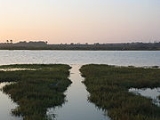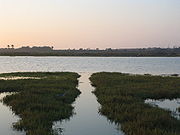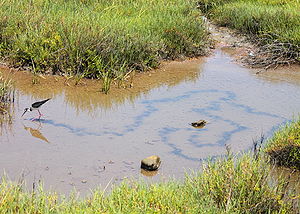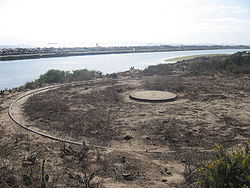
Bolsa Chica State Ecological Reserve
Encyclopedia
Bolsa Chica Ecological Reserve is a nature reserve
in the city of Huntington Beach, California
. It is designated by the California Department of Fish and Game
to protect a coastal wetland
, with its resident threatened and endangered species. "Bolsa Chica" means "little bag" in Spanish, as the area was part of a historic Mexican land grant
named Rancho La Bolsa Chica
.

 The Bolsa Chica Ecological Reserve boundaries are Warner Avenue to the north, Seapoint Avenue to the south, Pacific Coast Highway (PCH) to the west, and residential development to the east.
The Bolsa Chica Ecological Reserve boundaries are Warner Avenue to the north, Seapoint Avenue to the south, Pacific Coast Highway (PCH) to the west, and residential development to the east.
There are two small parking lots: the north lot southeast of the intersection of Warner and PCH, and the south lot on PCH across from the entrance to Bolsa Chica State Beach
. The north lot contains the Bolsa Chica Interpretive Center. Open seven days a week from 9 a.m. to 4 p.m., the Center offers live animal exhibits, aquaria, maps and information about Bolsa Chica and education programs on wetland science. It is the starting point for the Mesa Trail, which leads to the overlook and rest stop at Mesa Point. The south lot is the starting point for the 1.5 miles (2.4 km) Loop Trail, which crosses a wooden bridge, passes two overlooks, and returns to the parking lot via a sand-dune trail paralleling PCH.
 Hiking
Hiking
, photography
and birdwatching
are popular activities at the Reserve. In spring and fall, the Reserve is home to many migratory birds. As many as 321 out of Orange County's 420 bird species have been sighted at the Reserve in the past decade. Bird species at the reserve include the snowy plover
, savannah sparrow
, least tern, and Caspian tern
.
There are special regulations in force for the Bolsa Chica Ecological Reserve:
Among the wildlife in the Reserve are the shovelnose guitarfish
and grey smooth-hound
sharks.
The East Garden Grove Wintersburg Channel runs through the Reserve. Beginning in December 2007, flood control improvements were made by the County of Orange to reinforce the levees damaged in the rains of 2005
and protect the wetlands. In addition, the Newport-Inglewood Fault
goes through the reserve.
First Saturday at 9 a.m. is offered by the Amigos de Bolsa Chica from the south parking lot
Second Saturday from 10 a.m. to 12 noon is offered by the Bolsa Chica Conservancy from the north lot. Call 714.846.1114 to reserve a spot.
Third Sunday at 10 a.m. is conducted by the Bolsa Chica Land Trust.
in Santa Ana
.
Once Spain colonized California, Spanish officials created vast land grants called ranchos
. One such grant, Rancho Los Nietos
, was given to Manuel Nieto
. After Nieto died, the grant was partitioned in 1834 into five Mexican ranchos including Rancho Las Bolsas
. Rancho La Bolsa Chica was separated from Rancho Las Bolsas in 1841. The grant was later owned by Abel Stearns.
Prior to 1899, there had been a natural ocean entrance to the wetlands where the East Garden Grove Wintersburg Channel, then a small stream, is now located. In 1899, the Bolsa Chica Gun Club was formed by a group of wealthy businessmen from Los Angeles and Pasadena. They built a two-story structure on a mesa overlooking the Pacific Ocean. More significantly, the Gun Club is responsible for damming off of Bolsa Chica from direct tidal flow with the ocean.
It was in July 1920, that the Standard Oil Company entered a lease agreement with the Gun Club Board of Directors that would allow for them to begin oil extraction in between and around the Bolsa Wetlands. This contract specified that the initial bonus of $100,000 and subsequent revenues would be split 50/50 between the Bolsa Chica Gun Club and the Bolsa Chica Land Trust. Upon receipt of this money, it was then to be invested into “good, interest-bearing securities” (Board of Directors Meeting Jun 11, 1920).
In January 1921, in order to protect their newly acquired capital, The Gun Club assembled an investigative committee to complete a legal report that assessed the land title’s specifics in respect to protection from outside parties encroaching upon their tide and marshlands for oil drilling. The organization also wished to inquire as to whether they should pursue a specific title that would clearly define their rights in regard to oil drilling.
In the 1940s, it was feared that Japan would attack California. So the U.S. Military constructed two bunkers at Bolsa Chica to defend the coastline. Gun turret
s were also mounted on the mesa, but were only ever fired for testing purposes. The larger of the two bunkers was demolished in 1995. The smaller support bunker still exists but is closed off from public access. All that is left of the turrets are their circular frame. In the 1960s, most of Bolsa Chica was acquired by Signal Landmark and plans for a massive housing development and marina were released. State officials objected, and so in 1970 the developer set aside 300 acres (1.2 km²) alongside Pacific Coast Highway to create the Bolsa Chica Ecological Reserve. This action satisfied state officials but not members of the League of Women Voters
In the 1960s, most of Bolsa Chica was acquired by Signal Landmark and plans for a massive housing development and marina were released. State officials objected, and so in 1970 the developer set aside 300 acres (1.2 km²) alongside Pacific Coast Highway to create the Bolsa Chica Ecological Reserve. This action satisfied state officials but not members of the League of Women Voters
, who decided to create a new group, Amigos de Bolsa Chica ("Friends of Bolsa Chica"), to save and preserve more of the wetlands. Amigos were founded in 1976, and the 20-year battle to save the wetlands began.
In 1990, the Amigos and the developer, now called Koll Real Estate, entered a joint agreement to create the Bolsa Chica Conservancy. The Conservancy's mission is to educate the public about the importance of wetlands.
The size of Koll's development decreased over the years. In 1992, the Bolsa Chica Land Trust was formed by individuals who thought more of Bolsa Chica should be saved from development than just the wetlands. The upland habitat provided nesting, shelter, and food for egret
s, heron
s, and raptors
that also used the wetlands.
In 1997, the Amigos' long-awaited goal of preserving the wetlands was reached when the state of California purchased 880 acres (3.6 km²) of Koll's holdings. Restoration would come seven years later at a cost of $147 million.
In November 2000 the California Coastal Commission
, which regulates development along the state's coastline, ruled that development had to be limited to the upper half ("upper bench") of the Bolsa Chica mesa because the lower half ("lower bench") was too valuable as habitat. Koll—now called Hearthside Homes—sued. The case was eventually dismissed. The developer contributed to the campaign of bond measure Proposition 50, which included specific language to purchase land at Bolsa Chica. Proposition 50 passed, and the state ended up purchasing 118 acre (0.47752948 km²) of the lower bench, closing escrow in December 2005. Hearthside was free to develop the upper bench, and their 379-unit project (whittled down from the 5,000+ plan of the 1960s) broke ground in 2006.
A $151 million project that opened an inlet to the Pacific Ocean for the first time since being dammed in 1899 was completed in 2006.
An additional 56 acres (226,624.2 m²) of uplands still remains in private ownership and is being considered for development. Ongoing hearings are being held with the California Coastal Commission.
Nature reserve
A nature reserve is a protected area of importance for wildlife, flora, fauna or features of geological or other special interest, which is reserved and managed for conservation and to provide special opportunities for study or research...
in the city of Huntington Beach, California
Huntington Beach, California
Huntington Beach is a seaside city in Orange County in Southern California. According to the 2010 census, the city population was 189,992; making it the largest beach city in Orange County in terms of population...
. It is designated by the California Department of Fish and Game
California Department of Fish and Game
The California Department of Fish and Game is a department within the government of California, falling under its parent California Natural Resources Agency. The Department of Fish and Game manages and protects the state's diverse fish, wildlife, plant resources, and native habitats...
to protect a coastal wetland
Wetland
A wetland is an area of land whose soil is saturated with water either permanently or seasonally. Wetlands are categorised by their characteristic vegetation, which is adapted to these unique soil conditions....
, with its resident threatened and endangered species. "Bolsa Chica" means "little bag" in Spanish, as the area was part of a historic Mexican land grant
Ranchos of California
The Spanish, and later the Méxican government encouraged settlement of territory now known as California by the establishment of large land grants called ranchos, from which the English ranch is derived. Devoted to raising cattle and sheep, the owners of the ranchos attempted to pattern themselves...
named Rancho La Bolsa Chica
Rancho La Bolsa Chica
Rancho La Bolsa Chica was an Mexican land grant in present day coastal northwestern Orange County, California given in 1841 by Governor Juan Alvarado to Joaquín Ruiz. The name means "little pocket", and refers to pockets of land amongst the marsh wetlands of the Santa Ana River estuary...
.
About the Reserve


There are two small parking lots: the north lot southeast of the intersection of Warner and PCH, and the south lot on PCH across from the entrance to Bolsa Chica State Beach
Bolsa Chica State Beach
Bolsa Chica State Beach is a beach in the state park system of California, USA. It is located in the Huntington Beach community of Sunset Beach in Orange County....
. The north lot contains the Bolsa Chica Interpretive Center. Open seven days a week from 9 a.m. to 4 p.m., the Center offers live animal exhibits, aquaria, maps and information about Bolsa Chica and education programs on wetland science. It is the starting point for the Mesa Trail, which leads to the overlook and rest stop at Mesa Point. The south lot is the starting point for the 1.5 miles (2.4 km) Loop Trail, which crosses a wooden bridge, passes two overlooks, and returns to the parking lot via a sand-dune trail paralleling PCH.

Hiking
Hiking is an outdoor activity which consists of walking in natural environments, often in mountainous or other scenic terrain. People often hike on hiking trails. It is such a popular activity that there are numerous hiking organizations worldwide. The health benefits of different types of hiking...
, photography
Photography
Photography is the art, science and practice of creating durable images by recording light or other electromagnetic radiation, either electronically by means of an image sensor or chemically by means of a light-sensitive material such as photographic film...
and birdwatching
Birdwatching
Birdwatching or birding is the observation of birds as a recreational activity. It can be done with the naked eye, through a visual enhancement device like binoculars and telescopes, or by listening for bird sounds. Birding often involves a significant auditory component, as many bird species are...
are popular activities at the Reserve. In spring and fall, the Reserve is home to many migratory birds. As many as 321 out of Orange County's 420 bird species have been sighted at the Reserve in the past decade. Bird species at the reserve include the snowy plover
Snowy Plover
The Snowy Plover is a small wader in the plover bird family. It breeds in Ecuador, Peru, Chile, the southern and western USA and the Caribbean...
, savannah sparrow
Savannah Sparrow
The Savannah Sparrow is a small American sparrow. It is the only widely accepted member of the genus Passerculus...
, least tern, and Caspian tern
Caspian Tern
The Caspian Tern is a species of tern, with a subcosmopolitan but scattered distribution. Despite its extensive range, it is monotypic of its genus, and has no subspecies accepted either...
.
There are special regulations in force for the Bolsa Chica Ecological Reserve:
- Fishing shall be permitted at designated areas around outer Bolsa Bay only.
- Pets are prohibited from entering the reserve except when they remain inside a motor vehicle.
Among the wildlife in the Reserve are the shovelnose guitarfish
Shovelnose guitarfish
The shovelnose guitarfish, Rhinobatos productus, is a ray that becomes sexually mature at an estimated seven to eight years. Males are between 90–100 cm, while females are around 99 cm at this time. The ray can live up to 11 years, and full grown sizes are around 120 cm for males,...
and grey smooth-hound
Grey smooth-hound
The grey smooth-hound, Mustelus californicus, is a houndshark of the family Triakidae, found on the continental shelves of the subtropical eastern Pacific from northern California to the Gulf of California between latitudes 40° N and 23° N, from the surface to 200 m...
sharks.
The East Garden Grove Wintersburg Channel runs through the Reserve. Beginning in December 2007, flood control improvements were made by the County of Orange to reinforce the levees damaged in the rains of 2005
Pineapple Express
Pineapple Express is a non-technical term for a meteorological phenomenon characterized by a strong and persistent flow of atmospheric moisture and associated heavy rainfall from the waters adjacent to the Hawaiian Islands and extending to any location along the Pacific coast of North America...
and protect the wetlands. In addition, the Newport-Inglewood Fault
Newport-Inglewood Fault
The Newport-Inglewood Fault is a right-lateral fault in Southern California. The fault extends for from Culver City southeast to Newport Beach at which point it runs out into the Pacific Ocean. The fault can be seen on the Earth's surface as line of hills extending from Signal Hill to Culver City...
goes through the reserve.
Tours
Free public tours are offered each month by three organizations at Bolsa Chica.First Saturday at 9 a.m. is offered by the Amigos de Bolsa Chica from the south parking lot
Second Saturday from 10 a.m. to 12 noon is offered by the Bolsa Chica Conservancy from the north lot. Call 714.846.1114 to reserve a spot.
Third Sunday at 10 a.m. is conducted by the Bolsa Chica Land Trust.
History
The history of Bolsa Chica is a long and varied one. The earliest peoples were the native Indians of California. Archaeologists have found cog stones which date back 8,000 years and are the only surviving relic of the Indian lifestyle. Their exact purpose is unknown, but speculation has centered on religious or astronomical use. Cog stones can be seen at the Bowers MuseumBowers Museum
The Bowers Museum is located in Santa Ana, California, in Orange County. The museum offers exhibitions, lectures, art classes, travel programs, children’s art and music education programs, and other community events...
in Santa Ana
Santa Ana, California
Santa Ana is the county seat and second most populous city in Orange County, California, and with a population of 324,528 at the 2010 census, Santa Ana is the 57th-most populous city in the United States....
.
Once Spain colonized California, Spanish officials created vast land grants called ranchos
Ranchos of California
The Spanish, and later the Méxican government encouraged settlement of territory now known as California by the establishment of large land grants called ranchos, from which the English ranch is derived. Devoted to raising cattle and sheep, the owners of the ranchos attempted to pattern themselves...
. One such grant, Rancho Los Nietos
Rancho Los Nietos
Rancho Los Nietos was one of the first, and the largest, Spanish land concession in Alta California. Located in present day Los Angeles County and Orange County, California. Rancho Los Nietos was awarded to Manuel Nieto in 1784...
, was given to Manuel Nieto
Manuel Nieto
Jose Manuel Nieto was a soldier from the Presidio of San Diego who was assigned to the Mission San Gabriel at the time his land was granted by the Spanish Empire in 1784.-Spanish soldier:...
. After Nieto died, the grant was partitioned in 1834 into five Mexican ranchos including Rancho Las Bolsas
Rancho Las Bolsas
Rancho Las Bolsas was a 1834 Mexican land grant resulting from the partition of Rancho Los Nietos, located from the coast on inland within present day northwestern Orange County, California. The Spanish name "las bolsas" means "the pockets", and refers to pockets of land amongst the marsh ...
. Rancho La Bolsa Chica was separated from Rancho Las Bolsas in 1841. The grant was later owned by Abel Stearns.
Prior to 1899, there had been a natural ocean entrance to the wetlands where the East Garden Grove Wintersburg Channel, then a small stream, is now located. In 1899, the Bolsa Chica Gun Club was formed by a group of wealthy businessmen from Los Angeles and Pasadena. They built a two-story structure on a mesa overlooking the Pacific Ocean. More significantly, the Gun Club is responsible for damming off of Bolsa Chica from direct tidal flow with the ocean.
It was in July 1920, that the Standard Oil Company entered a lease agreement with the Gun Club Board of Directors that would allow for them to begin oil extraction in between and around the Bolsa Wetlands. This contract specified that the initial bonus of $100,000 and subsequent revenues would be split 50/50 between the Bolsa Chica Gun Club and the Bolsa Chica Land Trust. Upon receipt of this money, it was then to be invested into “good, interest-bearing securities” (Board of Directors Meeting Jun 11, 1920).
In January 1921, in order to protect their newly acquired capital, The Gun Club assembled an investigative committee to complete a legal report that assessed the land title’s specifics in respect to protection from outside parties encroaching upon their tide and marshlands for oil drilling. The organization also wished to inquire as to whether they should pursue a specific title that would clearly define their rights in regard to oil drilling.
In the 1940s, it was feared that Japan would attack California. So the U.S. Military constructed two bunkers at Bolsa Chica to defend the coastline. Gun turret
Gun turret
A gun turret is a weapon mount that protects the crew or mechanism of a projectile-firing weapon and at the same time lets the weapon be aimed and fired in many directions.The turret is also a rotating weapon platform...
s were also mounted on the mesa, but were only ever fired for testing purposes. The larger of the two bunkers was demolished in 1995. The smaller support bunker still exists but is closed off from public access. All that is left of the turrets are their circular frame.

League of Women Voters
The League of Women Voters is an American political organization founded in 1920 by Carrie Chapman Catt during the last meeting of the National American Woman Suffrage Association approximately six months before the Nineteenth Amendment to the United States Constitution gave women the right to vote...
, who decided to create a new group, Amigos de Bolsa Chica ("Friends of Bolsa Chica"), to save and preserve more of the wetlands. Amigos were founded in 1976, and the 20-year battle to save the wetlands began.
In 1990, the Amigos and the developer, now called Koll Real Estate, entered a joint agreement to create the Bolsa Chica Conservancy. The Conservancy's mission is to educate the public about the importance of wetlands.
The size of Koll's development decreased over the years. In 1992, the Bolsa Chica Land Trust was formed by individuals who thought more of Bolsa Chica should be saved from development than just the wetlands. The upland habitat provided nesting, shelter, and food for egret
Egret
An egret is any of several herons, most of which are white or buff, and several of which develop fine plumes during the breeding season. Many egrets are members of the genera Egretta or Ardea which contain other species named as herons rather than egrets...
s, heron
Heron
The herons are long-legged freshwater and coastal birds in the family Ardeidae. There are 64 recognised species in this family. Some are called "egrets" or "bitterns" instead of "heron"....
s, and raptors
Bird of prey
Birds of prey are birds that hunt for food primarily on the wing, using their keen senses, especially vision. They are defined as birds that primarily hunt vertebrates, including other birds. Their talons and beaks tend to be relatively large, powerful and adapted for tearing and/or piercing flesh....
that also used the wetlands.
In 1997, the Amigos' long-awaited goal of preserving the wetlands was reached when the state of California purchased 880 acres (3.6 km²) of Koll's holdings. Restoration would come seven years later at a cost of $147 million.
In November 2000 the California Coastal Commission
California Coastal Commission
The California Coastal Commission is a state agency in the U.S. state of California with quasi-judicial regulatory oversight over land use and public access in the California coastal zone....
, which regulates development along the state's coastline, ruled that development had to be limited to the upper half ("upper bench") of the Bolsa Chica mesa because the lower half ("lower bench") was too valuable as habitat. Koll—now called Hearthside Homes—sued. The case was eventually dismissed. The developer contributed to the campaign of bond measure Proposition 50, which included specific language to purchase land at Bolsa Chica. Proposition 50 passed, and the state ended up purchasing 118 acre (0.47752948 km²) of the lower bench, closing escrow in December 2005. Hearthside was free to develop the upper bench, and their 379-unit project (whittled down from the 5,000+ plan of the 1960s) broke ground in 2006.
A $151 million project that opened an inlet to the Pacific Ocean for the first time since being dammed in 1899 was completed in 2006.
An additional 56 acres (226,624.2 m²) of uplands still remains in private ownership and is being considered for development. Ongoing hearings are being held with the California Coastal Commission.

